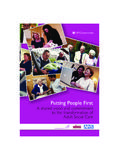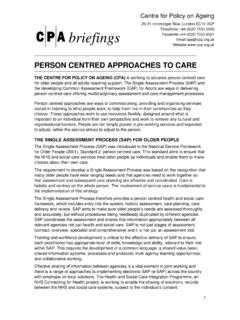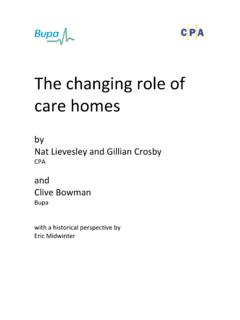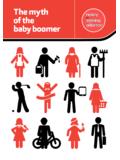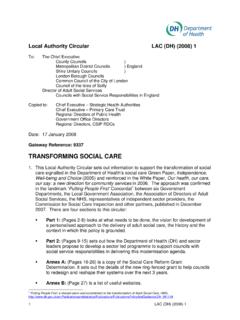Transcription of The effectiveness of care pathways in health and social care
1 Centre for Policy on Ageing Rapid review The effectiveness of care pathways in health and social care May 2014 The effectiveness of care pathways in health and social care Background care pathways , also known as clinical pathways , critical pathways , care paths, integrated care pathways , case management plans, clinical care pathways or care maps, are used to systematically plan and follow up a focused patient or client care programme. 1 care pathways are a way of setting out a process of best practice to be followed in the treatment of a patient or client with a particular condition or with particular needs. They are a distillation of the best available expert opinion on the care process and should be evidence based. care pathways , which map out the care journey an individual can expect, should be multi-professional, crossing organisational boundaries; and can act as a prompt for care .
2 They can also create a consistent standard of documentation which will provide the basis for ongoing audit. 2. Integrated care pathways (ICP), are care pathways which, in addition, and uniquely to ICP's, record deviations from planned care in the form of variances'. An Integrated care pathway is intended to act as a guide to treatment and an aid to documenting a patient/client's progress. Clinicians are free to exercise their own professional judgements as appropriate but any alteration to the practice identified within an ICP should be noted as a Variance'. 3. A survey carried out by the European pathway Association found that clinical pathways were predominantly viewed by their users as a multidisciplinary tool to improve the quality and efficiency of evidence-based care but are also used as a communication tool between professionals to manage and standardise outcome-oriented care pathways may be an attempt to level up' so that individual patients and clients all receive the best standard of care available but the counter-argument is that they are contrary to the concept of person-centred care , do not allow sufficiently for non-standard situations such as the presence of complex co- morbidities, and can become a tick-box exercise with too much pathway and too little care '.
3 4. 1. European pathway Association, p care 2. Centre for Policy on Ageing, Glossary of health and social care , #Care08 3. ICPUS (2007), A Workbook for People Starting to Develop Integrated care pathways 4. Neuberger et al (2013), More care , less pathway : a review of the Liverpool care pathway 1 Centre for Policy on Ageing Rapid review The effectiveness of care pathways in health and social care May 2014 The effectiveness of care pathways can be viewed in a number of ways. From the point of view of the patient or client, effectiveness will be seen in terms of improved clinical outcomes or improved levels of care and quality of life. A service administrator, while also seeking improved outcomes, may see effectiveness in terms of a reduction in costs and in the use of resources. Summary and key findings care pathways seek to document best practice in care for a well-defined group of patients or clients.
4 They are an attempt to level up' so that individual patients and clients all receive the best standard of care available care pathways are context-specific complex interventions so assessments of effectiveness may not be transferable care pathways are most effective in contexts where the trajectory of care is predictable Clinical pathways are associated with reduced in-hospital errors/complications and improved documentation without impacting on length of stay and hospital costs In general, care pathways report a positive impact on clinical outcomes, cost reduction, patient satisfaction, teamwork and process outcomes but these positive findings are not universal pathways have a significant impact on the organisation of care processes, however, pathway methodology does not have a significant impact on patient-focused organisation, communication with patients and family or collaboration with primary care care pathways have the potential of enhancing cross-setting collaboration and rebalancing care between hospital and local community provision but there is very little evidence of the use of care pathways in the community End-of-life care is a special circumstance with important patient and relative outcomes that may not be easily incorporated into a care pathway .
5 Implementation of the Liverpool care pathway , while having the good intention of setting end-of-life care standards has, on too many occasions, led to a withdrawal or reduction of care , a tick-box' mentality and actions which would appear to hasten the death of the patient. 2 Centre for Policy on Ageing Rapid review The effectiveness of care pathways in health and social care May 2014 The effectiveness of care pathways The development and use of care pathways pervades many areas of health and social care . Today, it would probably be difficult to find an area of health care in the UK for which a care pathway approach has not been attempted. A 2004. survey of health professionals in Europe 5 found that the perceived level of present and future adoption of care pathways was highest in the UK. care pathways are often developed at the local level to meet local needs, circumstances and expectations and so, even for the same type of care , these, locally developed, care pathways are likely to differ from one another not only in their content but also in their effectiveness .
6 A well designed care pathway will however include a framework for the evaluation and assessment of its own effectiveness . A 2005 evaluation of the quality of integrated care pathway development in the UK National health Service found that there was wide variability in the quality of the ICPs being developed, and the development of ICPs in many health - care organisations was inadequate. 6 Variability of the ICPs being developed may have a direct impact on the quality of patient care , and potential improvements in care and service delivery may not be identified, implemented or reviewed. care pathways are complex 7 and usually developed for a particular group of patients or clients with particular needs in particular circumstances. That means that the lessons learned about effectiveness in a particular context may not be transferrable.
7 They are most effective in circumstances where the trajectory of care is predictable 8. 5. Hindle and Yazbeck (2005), Clinical pathways in 17 European Union countries: a purposive survey 6. Croucher (2005), An Evaluation of the Quality of Integrated care pathway Development in the UK National health Service 7. Allen, Gillen and Rixson (2009), The effectiveness of integrated care pathways for adults and children in health care settings: a systematic review 3 Centre for Policy on Ageing Rapid review The effectiveness of care pathways in health and social care May 2014 Clinical outcomes The use of care pathways has been associated with reduced in-hospital complications 9 and strong positive effects on safety and quality of care 10 . Van Herck et al 11 found that of the included studies reported a positive effect on clinical outcomes, while 32% reported no effect and a negative effect.
8 Bandolier 12 reported on improved clinical outcomes for hip and knee replacements, fractured neck of femur, inpatient asthma management, community acquired pneumonia, heart failure, community acquired lower respiratory tract infections, bronchiolitis, and caesarean section. Hindle, Dowdeswell and Yasbeck 13 list earlier studies that describe positive effects on quality of care and patient outcomes for geriatric patients with depression, patients undergoing regional anaesthesia for outpatient orthopaedic surgery, pain management, neonatal intensive care , peri-operative settings, amputation, elective infrarenal aortic reconstructions, urology patients, inpatient asthma care and hip and knee arthroplasty. In contrast, Bryson & Browning 14 found very little evidence of improved outcomes and Every et al16 reported no change in clinical outcome or readmission rate with just one of the six publications in that review reporting a decreased rate of nosocomial (hospital-acquired) infection.
9 Cost effectiveness The goal of clinical pathways is to provide appropriate and effective health care and to reduce variation in practice. It is also considered as an effective means of reducing health care costs. 15. There is however a real danger when care pathways are brought in from external sources and implemented on the basis of administrative attempts to reduce costs. Although cost savings can and should be evaluated with the care pathway , the goal of improving guideline compliance and overall quality of care should be the primary focus. 16. In the review by Van Herck et al11 of the studies reported a positive effect on reducing costs, while described no effect and 4% a negative effect. A 2013 study 17 of the introduction of a clinical pathway in postoperative clinical care following major head and neck surgery found a 27% reduction in costs per patient and several other studies have identified reduced length of stay following pathway ,16,18,19.
10 8. Allen, Gillen and Rixson (2009), Systematic review of the effectiveness of integrated care pathways : what works, for whom, in what circumstances? 9. Rotter et al (2010), Clinical pathways : effects on professional practice, patient outcomes, length of stay and hospital costs 10. Mad et al (2008), Clinical pathways : systematic review of outcome parameters and effectiveness 11. Van Herk (2004), Effects of Clinical pathways : do they work? 12. Bandolier Forum (2003), On care pathways 13. Hindle, Dowdeswell and Yasbeck (2004), Report of a survey of clinical pathways and strategic asset planning in 17 EU countries 14. Bryson and Browning (1999), Clinical audit and quality using integrated pathways of care . Report No.: CA96/01 15. Sermeus et al (2005), An introduction to clinical pathways 16. Every et al (2000), Critical pathways : a review 4 Centre for Policy on Ageing Rapid review The effectiveness of care pathways in health and social care May 2014 Patient and client satisfaction In the review by Van Herck et al11 of the studies reviewed reported a positive effect on patient satisfaction while reported no change and a negative effect.

